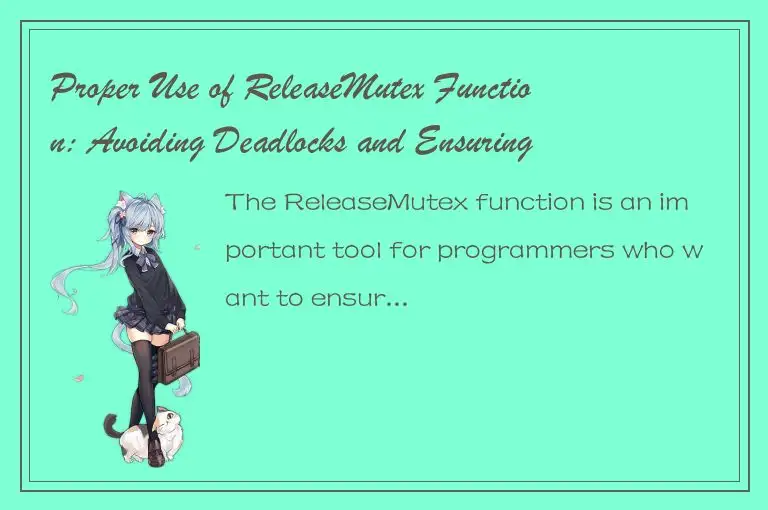The ReleaseMutex function is an important tool for programmers who want to ensure the proper synchronization of threads in their programs. However, it is not always easy to use it correctly, and there are many pitfalls and challenges to overcome in order to avoid deadlocks and ensure thread safety. In this article, we will discuss some best practices and guidelines for using the ReleaseMutex function effectively and safely.

Overview of Mutexes
Before delving into the details of the ReleaseMutex function, it is useful to have a basic understanding of mutexes and their role in thread synchronization. A mutex is a synchronization object that allows multiple threads to access a shared resource in a mutually exclusive manner. When a thread acquires a mutex, it gains exclusive access to the resource and all other threads that attempt to acquire the same mutex are blocked until the first thread releases the mutex.
Mutexes are useful for preventing race conditions and other synchronization issues in multithreaded programs. However, they can also be a source of problems if used incorrectly. For example, if a thread forgets to release a mutex after it is done with the shared resource, other threads will be blocked indefinitely, resulting in a deadlock.
The ReleaseMutex Function
The ReleaseMutex function is a Win32 API function that releases ownership of a specified mutex object. This allows other threads to acquire the mutex and gain access to the associated shared resource. The syntax of the ReleaseMutex function is as follows:
BOOL ReleaseMutex(
HANDLE hMutex
);
The parameter hMutex is a handle to the mutex object to be released.
Best Practices and Guidelines for Using ReleaseMutex
Now that we have a basic understanding of mutexes and the ReleaseMutex function, let's discuss some best practices and guidelines for using it effectively and safely.
1. Always release mutexes in a timely manner.
One of the most important things to remember when using mutexes is to release them as soon as they are no longer needed. Failure to release a mutex in a timely manner can result in deadlocks and other synchronization issues. To ensure that mutexes are released promptly, use a try-finally block to guarantee that the ReleaseMutex function is called even if an exception is thrown.
2. Avoid nested mutexes when possible.
Nested mutexes occur when a thread acquires more than one mutex at a time. While this is sometimes necessary, it can also lead to deadlock if not carefully managed. To avoid nested mutexes, try to structure your code so that each thread only acquires one mutex at a time.
3. Always check the return value of the ReleaseMutex function.
The ReleaseMutex function returns a BOOL value that indicates whether the call succeeded or failed. It is important to always check the return value to ensure that the mutex was actually released. If the function fails, it may be necessary to troubleshoot the cause of the failure and take corrective action.
4. Use named mutexes for interprocess synchronization.
If you need to synchronize threads across different processes, you should use named mutexes instead of anonymous mutexes. Named mutexes allow threads in different processes to share the same mutex object, avoiding the need for complex interprocess communication techniques that can be error-prone and difficult to debug.
5. Use a consistent naming convention for mutexes.
If you use multiple mutexes in your program, it is a good idea to use a consistent naming convention to ensure that they are easy to identify and manage. For example, you might prefix all mutex names with "mtx_" to make them easily recognizable as mutexes.
Conclusion
The ReleaseMutex function is an essential tool for ensuring thread safety and avoiding deadlocks in multithreaded programs. However, it is not always easy to use correctly, and there are many pitfalls and challenges to overcome. By following the best practices and guidelines outlined in this article, you can ensure that your use of the ReleaseMutex function is effective and safe.




 QQ客服专员
QQ客服专员 电话客服专员
电话客服专员